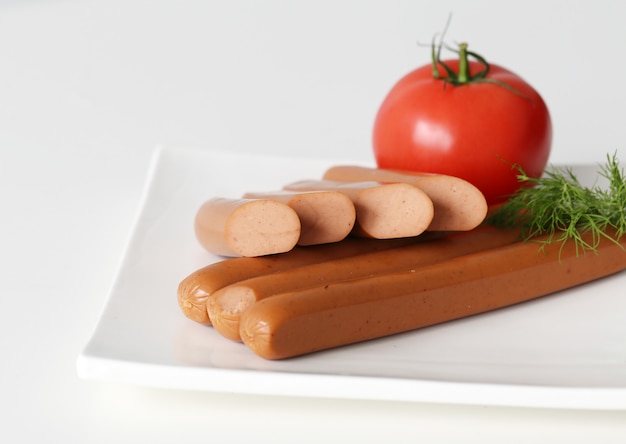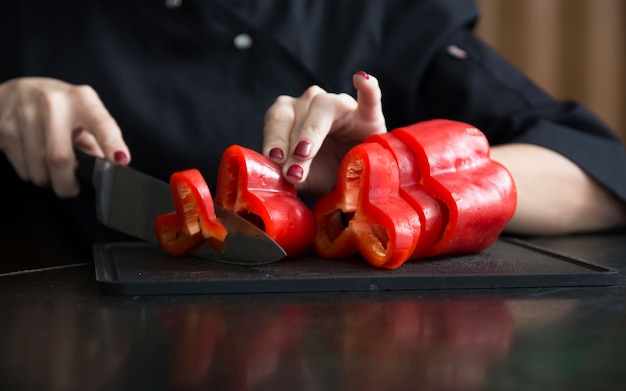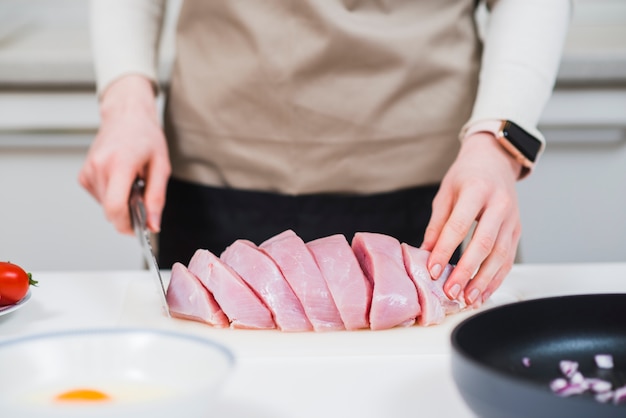Ah, sausages. They're a British staple, a comfort food, a perfect pub grub. Whether it's a classic bangers and mash, a hearty sausage roll, or just a simple sausage sizzle with some onion gravy, there's something about those little meaty tubes that just hits the spot. But, like anything in the kitchen, getting sausages just right takes a little know-how. No one wants dry, overcooked sausages or those pale, undercooked horrors. So, buckle up, sausage enthusiasts, because we're about to dive into the world of stovetop sausage cooking. We'll cover everything from picking the perfect sausage to mastering the art of the pan, ensuring you end up with a plate of perfect, juicy sausages that'll have you singing their praises.
(Part 1) The Sausage Odyssey: A Journey of Flavour and Choice

Let's start at the beginning: the sausages themselves. You see, not all sausages are created equal. There's a whole world out there, from the humble British banger to the spicy chorizo of Spain. Choosing the right sausage for your dish is like choosing the right wine for your meal - it makes all the difference.
Choosing the Right Sausage: A Flavourful Adventure
First, think about the flavour profile you're going for. Do you want a classic, mild flavour or something a bit more robust? Are you after a spicy kick? Or perhaps you're looking for a delicate, herby sausage? Once you know your flavour direction, you can start considering the type of meat. pork sausages are the classic choice, but you can also find delicious lamb, chicken, and even vegetarian sausages.
Now, let's talk about texture. Some sausages are coarse and chunky, packed with herbs and spices, while others are smoother and finer, offering a more delicate flavour. For a traditional British bangers and mash, you'd probably want a coarse sausage with a good amount of herbs. But for a lighter dish, a finer sausage might be a better choice.
And don't forget about the ingredients. Make sure you choose sausages that are made with high-quality ingredients. Check the label for any ingredients you might be allergic to or avoid.
And finally, don't be afraid to chat with your butcher. They're experts, after all, and they'll be able to guide you towards the perfect sausage for your needs. They can even tell you about special batches they've made or offer recommendations for different flavours and textures.
Sausage Sizes Matter: The Perfect Fit for Your Pan
Now, let's talk about size. Sausages come in all shapes and sizes, and it's important to consider this when planning your cooking time. Some sausages are small and bite-sized, perfect for a quick snack or a light meal. Others are long and thick, ideal for a hearty dinner. This difference in size will directly impact how long it takes to cook them.
Think of it this way: a smaller sausage will cook faster than a larger one because it has less surface area to cook through. We'll discuss the exact cooking times in the next section, but keep this size factor in mind.
(Part 2) The Stovetop Saga: Mastering the Art of cooking sausages

Now that we've chosen our sausages, it's time to get cooking! The stovetop is a great way to cook sausages because it allows for precise temperature control, ensuring even cooking. But before we get into the specifics, let's gather our tools.
Equipment Essentials: Your Stovetop Allies
- A good quality frying pan or skillet. This is your battleground. Choose a pan that's big enough to accommodate all of your sausages without overcrowding. You want them to have room to cook evenly and develop a nice golden brown crust.
- A spatula or tongs. You'll need these to flip the sausages and ensure they cook evenly on all sides. A good spatula with a flat edge will help you get under those sausages without breaking them.
- A meat thermometer. This is optional but highly recommended, especially for larger sausages. It allows you to check the internal temperature of the sausages to make sure they're cooked through. We'll talk more about temperature later on.
Cooking Methods: Exploring the Stovetop
Now, let's talk about the different cooking methods you can use on the stovetop. Each method offers a unique flavour and texture, so experiment and find your favourite.
Pan-Frying: The Classic Technique
Pan-frying is the most common and straightforward method. It's a great option for a classic, golden brown sausage with a slightly crispy exterior. Simply heat your frying pan over medium heat and add a little oil. Place your sausages in the pan, making sure not to overcrowd it. Cook them for about 5-7 minutes per side, or until they are golden brown and cooked through. You can add some onions or garlic to the pan for extra flavour. The aroma of sizzling garlic and sausage is enough to make anyone's mouth water.
Sautéing: A High-Heat Approach
Sautéing is similar to pan-frying, but it involves cooking the sausages over a higher heat. You'll use more oil and cook the sausages for a shorter period of time, resulting in a crispier exterior. This method is great for quickly cooking up a batch of sausages. It's perfect for a quick sausage sandwich or for adding sausages to a stir-fry.
Simmering: Gentle Cooking for a Tender Sausage
If you're looking for a more gentle and less intense cooking method, simmering is a good option. Simply place your sausages in a saucepan with enough liquid to cover them. Bring the liquid to a simmer and cook the sausages for 10-15 minutes, or until they are cooked through. This method is perfect for making sausage stew or sausages in gravy. The simmering liquid adds moisture to the sausages, creating a tender and juicy result.
(Part 3) Cooking Times: Understanding the Sausage Clock

Okay, we've covered the basics, but now let's get down to the nitty-gritty: cooking times! As I mentioned before, the size of your sausages will significantly impact how long they need to cook.
Size Matters: A Guide to Sausage Cooking Times
To give you a general idea, here's a table with approximate cooking times for different sausage sizes:
| Sausage Size | Cooking Time |
|---|---|
| Small (bite-sized) | 5-7 minutes per side |
| Medium | 7-10 minutes per side |
| Large (thick) | 10-15 minutes per side |
Remember, these are just approximate times. The actual cooking time will vary depending on the thickness of the sausages, the heat of your stove, and the cooking method you're using.
Don't Overcook It!
Overcooked sausages are a real tragedy. They become dry, tough, and lose their flavour. So, pay close attention to your sausages while they're cooking. You want them to be cooked through, but not overdone.
If you're unsure, use a meat thermometer. The internal temperature of the sausages should reach 155°F (68°C). This ensures that the sausage is safely cooked through while retaining its juicy texture.
To test for doneness without a thermometer, gently press on the sausage. If it feels firm and springy, it's likely cooked through. If it feels soft and mushy, it needs more cooking.
(Part 4) The Finishing Touches: Elevate Your Sausage Game
Alright, your sausages are cooked to perfection. Now it's time to add those finishing touches that will elevate your sausage dish from good to absolutely brilliant.
Add Some Flavour: Herbs, Spices, and Sauces
Don't be afraid to get creative here. You can add a variety of herbs and spices to your sausages while they're cooking. A sprinkle of thyme, rosemary, or sage will add a lovely herbal aroma. For a kick, add some chilli flakes or paprika.
If you're feeling adventurous, try adding a splash of wine or beer to the pan while the sausages are cooking. This will create a rich, savoury sauce that complements the sausages perfectly. And, of course, a good dollop of mustard on the side never hurts!
side dishes: The Perfect Sausage Companions
No sausage dish is complete without a good side dish. Here are some ideas to get you started, but feel free to get creative and add your own favourites:
- mashed potatoes: A classic pairing for sausages, mashed potatoes provide a creamy and comforting counterpoint to the savoury sausages.
- Roasted vegetables: Roasted vegetables like carrots, onions, and potatoes add a touch of sweetness and texture to your sausage dish.
- Sautéed mushrooms: Mushrooms add a rich, earthy flavour that complements sausages beautifully.
- green beans or peas: For a touch of freshness, add some green beans or peas to your sausage dish.
- Onion gravy: A hearty and delicious sauce that brings everything together.
- Apple sauce: A sweet and tart contrast to the savory sausage, adding a delightful complexity to the dish.
- Coleslaw: A refreshing and crunchy side that balances the richness of the sausages.
(Part 5) Sausage Safety: Keeping It Safe and Sound
Now, let's talk safety. It's important to handle sausages with care, especially when cooking them, to ensure they're safe to eat.
food safety Tips: Handling Sausages Responsibly
Here are a few key points to keep in mind:
- Keep sausages refrigerated. Don't let them sit out at room temperature for too long. Sausages, like other meat products, are susceptible to bacteria growth.
- Cook sausages thoroughly. Make sure the internal temperature reaches 155°F (68°C). This will kill any harmful bacteria.
- Wash your hands and surfaces. Wash your hands thoroughly with soap and water before and after handling raw sausages. Also, wash any surfaces that have come into contact with raw sausages.
- Avoid cross-contamination. Use separate cutting boards and utensils for raw and cooked meat. This will prevent the spread of bacteria.
(Part 6) Sausage Leftovers: Turning Leftovers into Deliciousness
So, you've cooked up a storm of sausages, and you've got leftovers. Don't despair! Leftover sausages can be used to create a variety of delicious meals.
Reheating Leftover Sausages: A Quick Guide
To reheat your leftover sausages, you can use a variety of methods. Here are a few options:
- In the oven: Preheat your oven to 350°F (175°C) and bake the sausages for 10-15 minutes, or until they are heated through.
- In a frying pan: Heat a little oil in a frying pan over medium heat and cook the sausages for 5-7 minutes, or until they are heated through.
- In the microwave: This is a quick and easy method, but it can sometimes make the sausages dry. Microwave the sausages on high for 1-2 minutes, or until they are heated through.
Leftover sausage recipes: Get Creative
Here are a few ideas for using leftover sausages in new dishes:
- Sausage and bean stew: Combine leftover sausages with beans, vegetables, and a hearty broth for a satisfying stew.
- Sausage pasta: Add leftover sausages to your favourite pasta dish for a quick and easy meal.
- sausage sandwiches: Slice up leftover sausages and use them to make delicious sandwiches with your favourite fillings.
- sausage rolls: Use leftover sausages to create delicious sausage rolls.
- Sausage and potato hash: Dice leftover sausages and combine them with potatoes, onions, and peppers for a hearty hash.
- Sausage breakfast burritos: Combine leftover sausages with eggs, cheese, and your favourite breakfast fillings for a delicious and hearty burrito.
(Part 7) Sausage Adventures: Exploring Beyond the Ordinary
Now, let's get a little adventurous! Beyond the classic pan-fried sausages, there are a whole world of ways to cook and enjoy sausages.
Grilled Sausages: The Outdoor Delight
Grilling sausages is a fantastic way to bring out their smoky flavour. Simply preheat your grill to medium heat and cook the sausages for 5-7 minutes per side, or until they are golden brown and cooked through. For extra flavour, try grilling them over a bed of wood chips or grilling them with a marinade.
Baked Sausages: A Simple and Delicious Option
Baking sausages is a great option if you want a hands-off cooking method. Simply place the sausages on a baking sheet lined with parchment paper and bake them in a preheated oven at 350°F (175°C) for 20-25 minutes, or until they are cooked through. You can also bake them with other ingredients, like onions, peppers, and potatoes, for a complete meal.
Sausage Skewers: A Fun and Festive Option
Sausage skewers are a fun and festive way to cook sausages. Simply thread the sausages onto skewers along with your favourite vegetables and grill or bake them until they are cooked through. This is a great way to serve sausages at a party or barbecue.
Sausage Rolls: A Classic British Treat
Sausage rolls are a beloved British classic and a delicious way to enjoy sausages. Simply wrap sausage meat in puff pastry and bake until golden brown. Sausage rolls are perfect for picnics, parties, or as a simple snack.
(Part 8) Sausage FAQs: Answering Your Burning Questions
Now, let's address some common questions you might have about cooking sausages.
FAQs:
- Q: Can I cook sausages in a microwave?
A: Yes, you can cook sausages in a microwave, but it's not the most ideal method. Microwaving can sometimes make the sausages dry and rubbery. It's best to stick to stovetop, oven, or grill methods for the best results.
- Q: How do I know if sausages are cooked through?
A: You can tell if sausages are cooked through by checking their internal temperature with a meat thermometer. The internal temperature should reach 155°F (68°C). You can also check the sausages for a firm texture and a golden brown colour. If you gently press on a sausage and it feels springy, it's likely cooked through.
- Q: Can I freeze sausages?
A: Yes, you can freeze sausages. To freeze them, place them in a freezer-safe bag or container and freeze for up to 2 months. To thaw frozen sausages, place them in the refrigerator overnight. You can also cook frozen sausages directly from the freezer, but you'll need to add a few extra minutes to the cooking time.
- Q: What's the best way to reheat leftover sausages?
A: The best way to reheat leftover sausages is in the oven or on the stovetop. You can also reheat them in the microwave, but this can sometimes make them dry. For the oven, preheat it to 350°F (175°C) and bake the sausages for 10-15 minutes, or until they are heated through. For the stovetop, heat a little oil in a frying pan over medium heat and cook the sausages for 5-7 minutes, or until they are heated through.
- Q: What are some good sausage recipes?
A: There are endless possibilities when it comes to sausage recipes! You can find recipes for everything from classic sausage and mash to more adventurous dishes like sausage stew or sausage pasta. For inspiration, search online or browse your favourite cookbooks.
There you have it! A comprehensive guide to cooking sausages on the stovetop. Remember, the key to successful sausage cooking is choosing the right sausage, using the right cooking method, and paying attention to the cooking time. With a little practice, you'll be a sausage master in no time! So go forth, sausage aficionados, and cook up a storm!
Everyone is watching

Perfect Rice Every Time: The Ultimate Guide to Cooking Rice
Cooking TipsAs a self-proclaimed foodie, I've always been a bit obsessed with rice. It's the foundation of countless cuisi...

Prime Rib Roast Cooking Time Chart: Per Pound Guide
Cooking TipsPrime rib roast. Just the name conjures images of lavish dinners, crackling fires, and hearty laughter. It’s ...

The Ultimate Guide to Cooking Asparagus: Tips, Techniques, and Recipes
Cooking TipsAsparagus. The mere mention of this spring delicacy conjures up images of vibrant green spears, crisp and burs...

Ultimate Guide to Cooking the Perfect Thanksgiving Turkey
Cooking TipsThanksgiving. Just the word conjures up images of overflowing tables laden with delicious food, the scent of r...

How Long to Bake Potatoes in the Oven (Perfect Every Time)
Cooking TipsBaked potatoes are a staple in my kitchen. They're incredibly versatile, delicious, and surprisingly easy to m...
